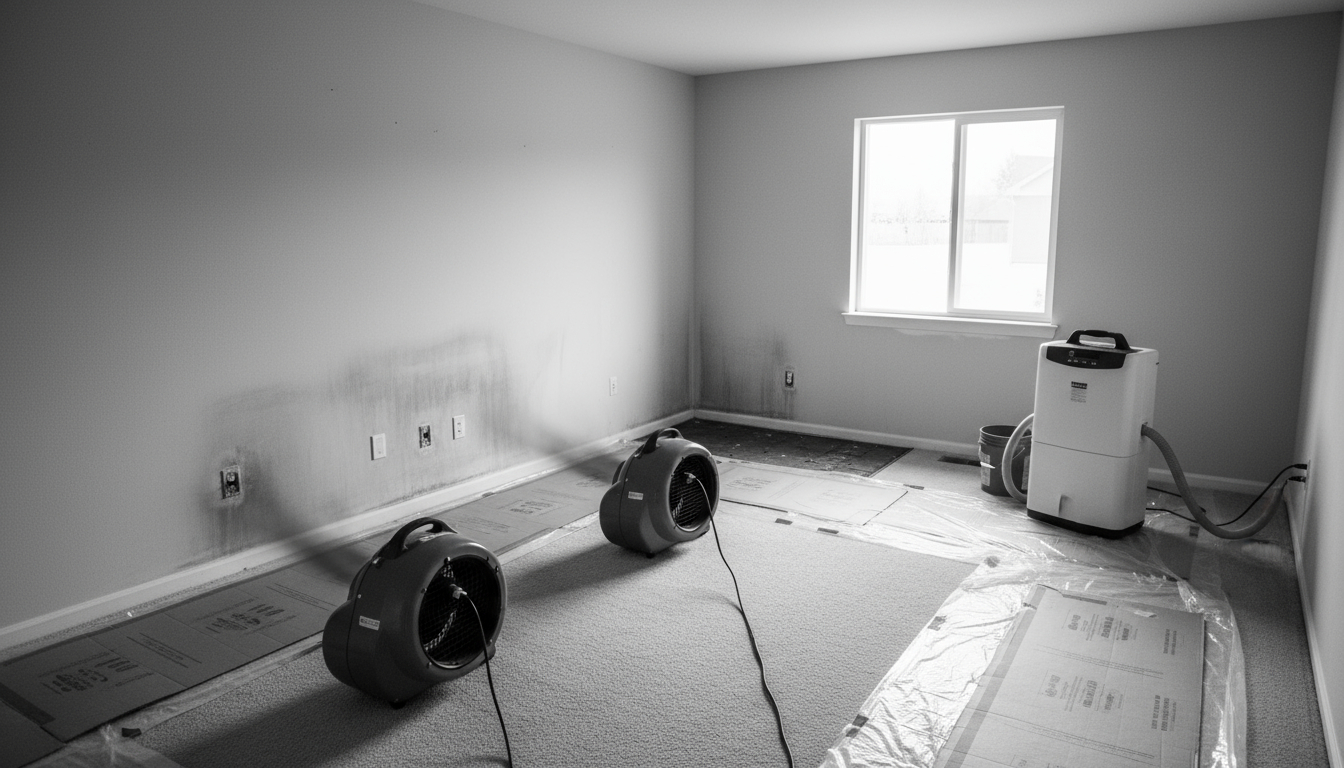What is Water Damage Restoration?
Water damage restoration is vital in maintaining the integrity of your home and ensuring a safe environment for your family.
Water damage restoration encompasses the complete process of returning a water-damaged property to its pre-loss condition through water extraction, drying, cleaning, and reconstruction. Think of it as reversing time—restoration service teams don’t just dry visible water but address hidden moisture, prevent secondary damage, and restore your property’s structural integrity and indoor air quality.
The restoration process combines industrial science with practical expertise, utilizing psychrometry (the study of air and moisture relationships), advanced drying technology, and antimicrobial treatments. Restoration service addresses three critical phases: mitigation (stopping ongoing damage), remediation (removing contaminants and moisture), and restoration (rebuilding and refinishing). Each phase requires specific expertise, equipment, and timing to prevent permanent damage and help property owners recover.
Modern restoration goes beyond simple water removal. Service teams must understand building science, moisture dynamics, and material-specific drying requirements. A typical residential water loss involves extracting hundreds to thousands of gallons of water, requiring industrial equipment and expertise far beyond consumer-grade tools. Water damage restoration services ensure complete recovery while preventing future problems and helping families return to normal, particularly crucial in older homes throughout Philadelphia’s Main Line and historic districts.
Engaging in water damage restoration immediately can save you time and money in the long run—call for help at the first signs of damage.
How Does Water Damage Restoration Work?
Understanding the restoration process helps property owners make informed decisions during stressful emergency situations. Expert restoration follows established industry protocols ensuring thorough, safe recovery.
Water damage restoration teams are trained to handle various scenarios effectively and help minimize damage.
The Eight-Step Restoration Process
1. Emergency Contact and Response: 24/7 response teams mobilize within 1 hour of your call
2. Inspection and Assessment: Service technicians identify water source, contamination level, and affected areas
3. Water Extraction: Powerful pumps and vacuums remove standing water
4. Damaged Material Removal: Non-salvageable materials are documented and removed
5. Drying and Dehumidification: Industrial equipment establishes optimal drying conditions
6. Cleaning and Sanitization: Antimicrobial treatments prevent mold and bacteria growth
7. Monitoring: Daily moisture readings track drying progress
8. Restoration: Repair teams return property to pre-loss condition
Each step of the water damage restoration process is designed to address specific issues that arise from water intrusion and help prevent further damage.
💡 Pro Tip: Document everything with photos and videos before restoration service begins. This documentation proves invaluable for insurance claims and ensures nothing gets overlooked during recovery.
The science behind effective drying involves creating optimal vapor pressure differentials. By heating affected areas to optimal temperatures while maintaining controlled relative humidity, restoration teams accelerate evaporation rates significantly compared to natural drying. This scientific approach is particularly important in humid Mid-Atlantic climates from Newark to Baltimore.
Ensuring a proper water damage remediation process can prevent long-term issues like mold growth.
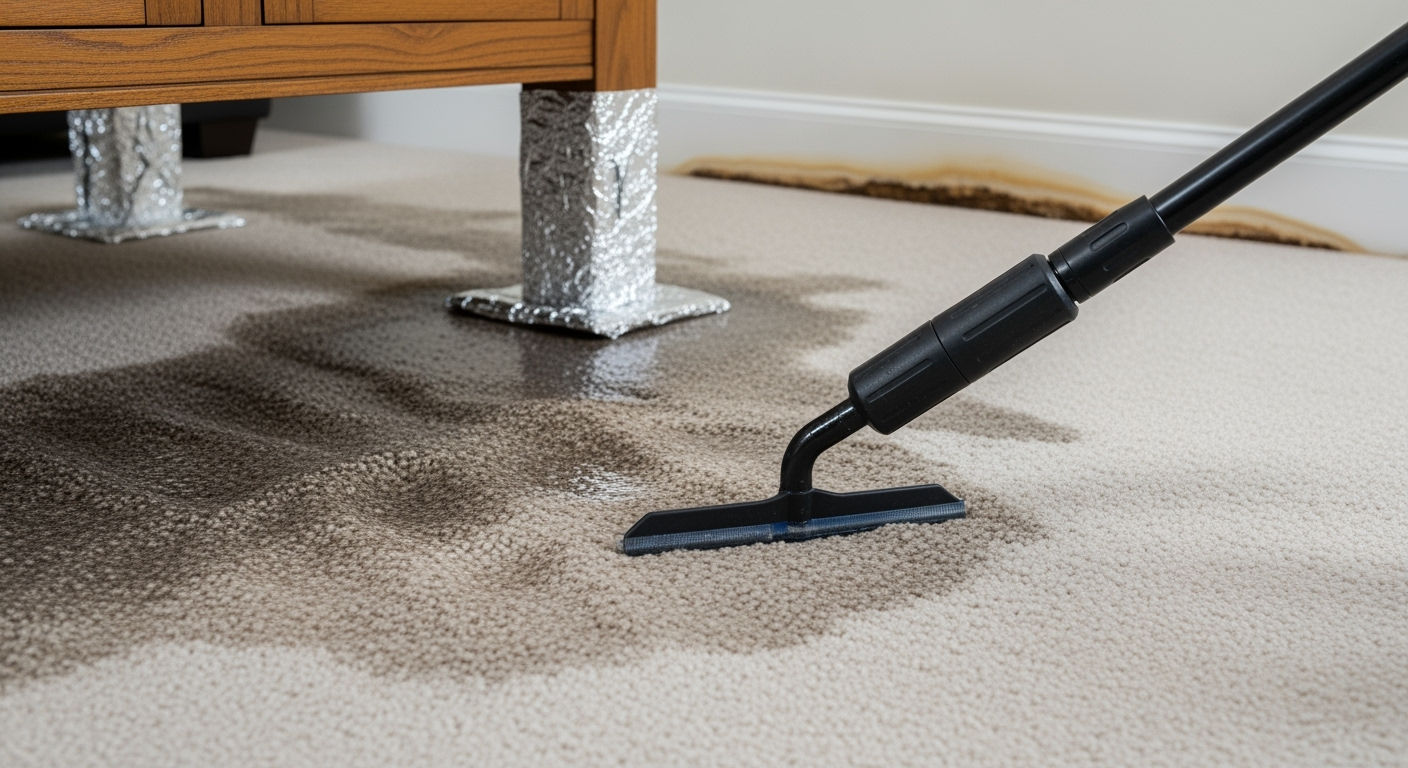
Types and Categories of Water Damage
Not all water damage is equal—understanding categories and classes helps determine appropriate restoration approaches and health precautions.
Water Categories (Contamination Levels)
Category 1 – Clean Water: Originates from sanitary sources like broken supply lines, sink overflows, or rainwater without contaminants. While initially clean, Category 1 water becomes Category 2 within approximately two to three days as bacteria multiply. Clean water represents a significant portion of water damage incidents requiring service calls across the Delaware Valley region.
Knowing the categories of water damage can help you understand the urgency of remediation service required.
Category 2 – Gray Water: Contains significant contamination potentially causing illness if consumed. Sources include washing machine overflows, dishwasher leaks, and toilet overflows with urine. Gray water requires protective equipment during cleanup and antimicrobial treatments. This category represents many water losses requiring remediation teams throughout Pennsylvania and New Jersey communities.
Category 3 – Black Water: Grossly contaminated water containing pathogenic agents, toxic materials, or sewage. Sources include sewer backups, storm flooding from rivers, and standing water supporting microbial growth. Black water demands extensive PPE, specialized cleaning protocols, and often requires removing porous materials. Emergency response teams handle Category 3 incidents with maximum safety precautions to help protect occupants.
Water Damage Classes (Severity/Extent)
When assessing water damage, it’s essential to consider the level of remediation service needed based on the classification of the water. Understanding the classes of water damage is crucial for effective restoration and repair work.
| Class | Description | Affected Materials | Drying Difficulty | Typical Timeline |
|---|---|---|---|---|
| Class 1 | Minimal water absorption | Part of one room, minimal carpet | Least difficult | 2-3 days |
| Class 2 | Significant water absorption | Entire room, carpet, pad, walls up 24″ | Moderate | 3-5 days |
| Class 3 | Greatest water absorption | Ceilings, walls, insulation, subfloor | Most difficult | 5-7 days |
| Class 4 | Specialty drying situations | Hardwood, plaster, concrete, crawlspaces | Specialized | 7-14+ days |
⚠️ Important: Never enter standing water without confirming electrical safety. Water conducts electricity, and submerged outlets or appliances create electrocution hazards. Wait for service teams to ensure safe conditions—call for help immediately.
Common Water Damage Sources
Understanding typical water damage causes helps identify risks and implement prevention strategies:
– Plumbing failures: Burst pipes, failed connections, supply line breaks (most common incidents requiring repair service, especially during Pennsylvania’s freeze-thaw cycles)
– Weather events: Storm damage, flooding, roof leaks, ice dams (frequent in Northeast winters)
– Appliance malfunctions: Water heaters, washing machines, dishwashers
– HVAC issues: Condensate line clogs, frozen coils (common in humid New Jersey summers)
– Human error: Overflows, left faucets running
Effective water damage remediation starts with identifying common sources of water damage that require repair.
Benefits of Expert Water Damage Restoration
While DIY cleanup might seem economical, expert restoration service provides critical advantages protecting your property and health.
Rapid Response and Mitigation
Restoration service companies maintain 24/7 emergency response teams arriving within one to two hours of your call for help. This rapid response prevents secondary damage—every hour of delay allows water to penetrate deeper into materials, significantly increasing damage and restoration complexity. Immediate expert intervention typically reduces overall restoration time substantially, particularly important in densely populated areas like Chester County and Bucks County.
Responding quickly to water damage can significantly impact the outcome of your remediation service.
Industrial-grade extraction equipment removes water exponentially faster than shop vacuums. Truck-mounted extractors generate powerful suction, pulling water from carpet padding and subfloors impossible to reach with consumer equipment—service teams help ensure complete water removal.
Advanced Equipment and Techniques
Expert restoration employs specialized equipment unavailable to consumers. Industrial dehumidifiers remove substantially more moisture daily versus rental units. Air movers create powerful airflow, establishing proper drying conditions throughout affected areas to help prevent secondary damage in New Jersey’s high-humidity environment.
Moisture detection technology identifies hidden water consumer tools miss. Thermal imaging cameras detect temperature differentials indicating moisture behind walls. Penetrating and non-penetrating moisture meters map water migration patterns. Hygrometers monitor ambient conditions ensuring optimal drying parameters during remediation service, particularly important in historic Philadelphia buildings with plaster walls.
Mold Prevention
Mold begins growing within one to two days in moist conditions, making prevention critical during water damage restoration. Service teams apply EPA-registered antimicrobials preventing mold colonization on affected surfaces. Proper drying protocols ensure moisture content drops below critical thresholds for mold growth.
Without expert intervention, most water damage incidents develop mold problems within two weeks. Once established, mold remediation costs exceed initial water damage restoration, making prevention economically crucial. Expert mold prevention and remediation service protects both property value and occupant health—call specialists when you need help, especially in Lehigh Valley’s naturally humid climate.
Insurance Coordination
Having experts handle your water damage restoration ensures thorough documentation for insurance purposes and helps maximize your claim.
Restoration teams work directly with insurance companies, understanding documentation requirements and claim procedures. They provide detailed estimates using industry-standard pricing software insurers recognize. Photo documentation, moisture logs, and detailed work records support your claim, often improving settlements considerably, particularly important after Northeast coastal storms.
🏠 Home Tip: Save all restoration documentation including moisture readings, equipment placement records, and daily progress reports. This paperwork proves thoroughness if problems arise later and helps with future claims.
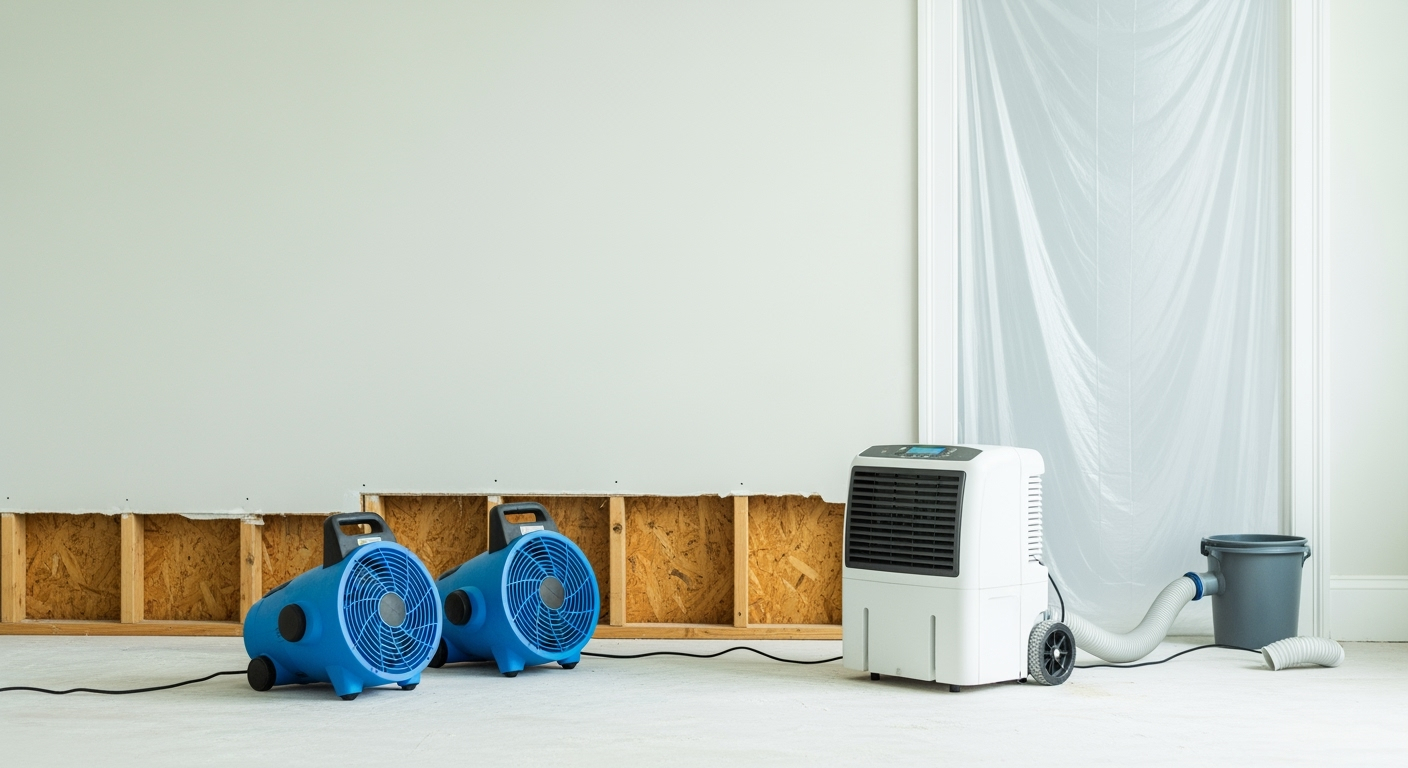
The Water Damage Restoration Process
Expert restoration follows systematic protocols ensuring complete recovery while minimizing disruption to your life.
The water damage remediation process requires careful attention to detail to prevent future issues and help families recover.
Initial Assessment and Inspection
Service technicians begin with comprehensive property assessment identifying all affected areas and safety hazards. Moisture mapping using specialized meters creates baseline documentation showing water migration patterns. This assessment determines restoration scope, equipment needs, and timeline estimates to help plan the repair process.
Pre-testing salvageable contents identifies items requiring specialized cleaning. Furniture, electronics, documents, and artwork receive appropriate treatment protocols. Items beyond restoration are documented for insurance purposes before disposal—teams help ensure nothing valuable is overlooked.
Water Extraction Phase
Standing water removal begins immediately using submersible pumps for deep water and truck-mounted extractors for surface water. Service technicians extract water from carpets using weighted extraction tools and specialized wands. Hard surface areas receive squeegee and wet-vacuum treatment ensuring complete water removal.
Extraction efficiency dramatically impacts drying time. Removing nearly all standing water reduces drying time by half compared to less thorough removal. Expert extraction achieves maximum efficiency through multiple passes and specialized techniques that help accelerate the repair timeline.
Concrete and Masonry Drying
Concrete and screed require special attention during water damage restoration, as they dry significantly slower than other materials. While the surface may feel dry to touch, the core often retains moisture for weeks or even months. Service teams use specialized testing methods including calcium carbide (CM) testing or gravimetric analysis to accurately measure moisture content deep within concrete structures, particularly important in Pennsylvania’s many concrete block foundations.
Moisture thresholds must be respected before installing floor coverings or coatings—premature installation leads to adhesive failure, mold growth, and flooring damage. For standard concrete, moisture content typically needs to drop below 4% CM or 75% relative humidity before floor coverings can be safely installed. Accelerated drying techniques including desiccant dehumidifiers and heat application help expedite the process, but patience is essential—rushing concrete drying causes expensive failures requiring complete reinstallation.
Basements throughout the Delaware Valley often feature concrete floors and walls requiring extended drying times. Service teams monitor multiple depths using specialized probes, ensuring complete drying before applying sealers or finishing materials. This thorough approach prevents future moisture problems that could compromise indoor air quality and structural integrity.
Demolition and Debris Removal
Non-salvageable materials require prompt removal preventing contamination spread and enabling structural drying. Typical removals during remediation include:
– Saturated drywall up to 24 inches above water lines
– Wet insulation losing R-value permanently
– Carpet padding absorbing contaminants
– Baseboards preventing wall cavity drying
Controlled demolition minimizes reconstruction needs while ensuring complete moisture elimination. Service teams document all removals with photos and measurements for insurance and reconstruction purposes—call for help determining what can be saved.
Drying and Dehumidification
Scientific drying establishes optimal conditions accelerating evaporation while preventing secondary damage. Air movers positioned using calculated patterns create vortex drying, maximizing evaporation rates. Dehumidifiers maintain controlled relative humidity, pulling moisture from air and materials during the remediation process, crucial in Montgomery County’s variable climate.
Utilizing advanced techniques during the water damage restoration phase is essential for achieving optimal results and helping prevent future repair needs.
A thorough cleaning during water damage remediation prevents contaminants from affecting your home. With proper equipment, restoration teams ensure that every step of the service is effective.
| Drying Stage | Duration | Focus | Moisture Goal | Equipment Ratio |
|---|---|---|---|---|
| Initial | Days 1-2 | Surface water | Below 20% | 1 air mover per 10-16 sq ft |
| Evaporation | Days 2-4 | Bound water | Below 16% | Maintain initial setup |
| Equilibrium | Days 4-5 | Deep moisture | Match unaffected | Reduce as areas dry |
Cleaning and Sanitization
Once dry, thorough cleaning removes contaminants and odors. HEPA vacuuming captures fine particles and allergens from surfaces. Antimicrobial applications prevent microbial growth on structural materials. Specialized cleaning addresses contents based on material types and contamination levels—remediation teams help restore cherished belongings.
Post-restoration, understanding the importance of water damage remediation can help maintain your property.
Odor removal requires identifying and treating sources, not masking smells. Service experts use thermal fogging, ozone treatment, or hydroxyl generators neutralizing odor molecules at the source. Complete odor elimination often requires treating hidden areas like wall cavities and crawlspaces.
Restoration and Reconstruction
Final restoration returns your property to pre-loss condition through repair work and reconstruction. Minor restoration includes:
– Replacing drywall sections
– Installing new carpet padding
– Painting affected walls
– Replacing baseboards and trim
Major restoration and repair might involve:
– Reconstructing entire rooms
– Replacing subfloors
– Installing new cabinetry
– Structural repairs after storm damage
Expert restoration ensures work meets building codes and matches existing finishes. Commercial properties often require specialized restoration teams maintaining business-specific requirements and minimizing operational disruption—call for immediate help.
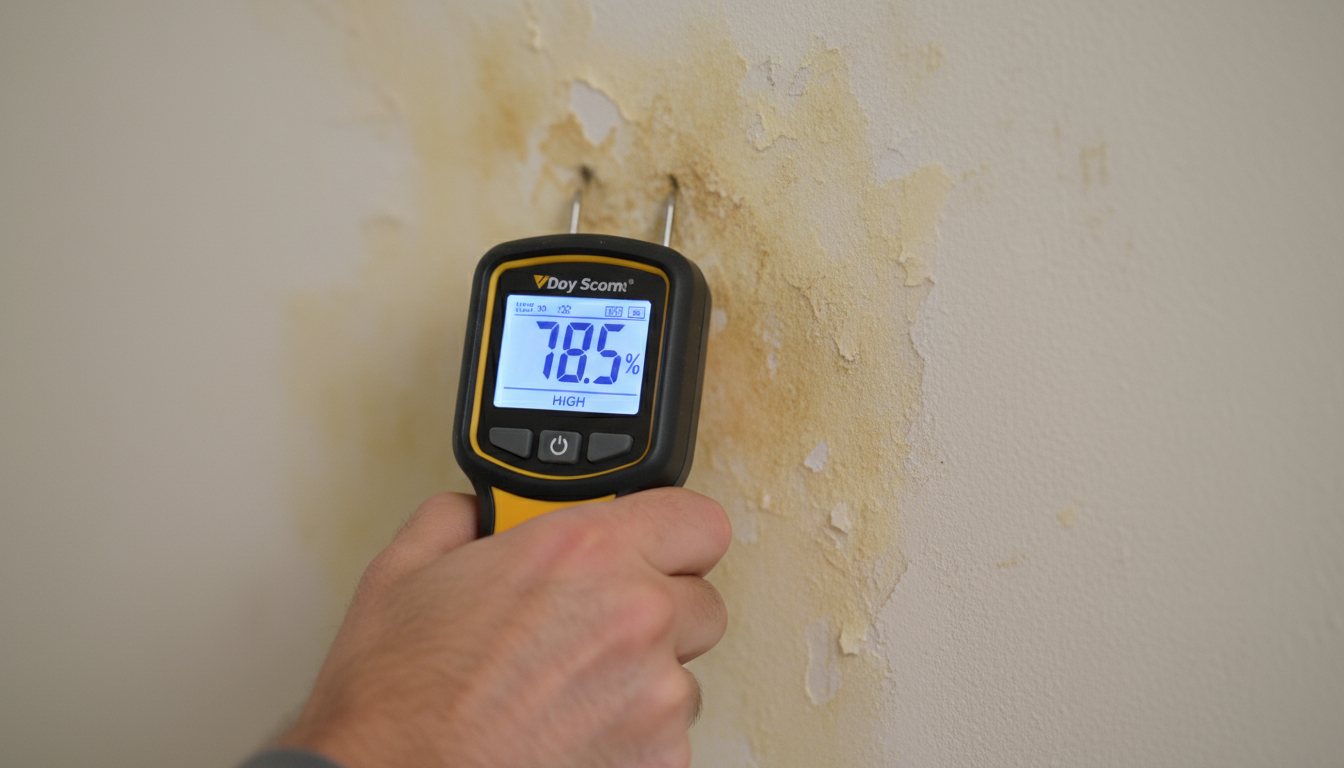
Equipment and Technology Used
Investing in expert water damage restoration services can pay off in the long run and help prevent recurring issues.
Expert restoration relies on specialized equipment designed for rapid, thorough water removal and drying.
Water Extraction Equipment
Truck-mounted extractors generate powerful suction through PTO-driven vacuum systems, removing large volumes of water per minute. Portable extractors access areas trucks cannot reach while providing strong suction power. Submersible pumps handle deep standing water efficiently—service teams select appropriate equipment to help expedite water removal throughout Camden County properties.
Specialized extraction tools maximize water removal from different surfaces:
Utilizing specialized tools during water damage remediation significantly improves the efficiency of the repair process.
– Weighted extraction tools compress carpet, squeezing water from padding
– Light wands extract from delicate materials without damage
– Hard surface tools with squeegee attachments ensure complete removal from solid floors
Drying Equipment
Centrifugal air movers create high-velocity airflow patterns essential for evaporation. Expert units deliver powerful CFM while operating continuously for weeks. Low-grain refrigerant dehumidifiers remove substantial moisture daily at optimal efficiency. Desiccant dehumidifiers handle extreme moisture loads—remediation teams strategically place equipment to help accelerate drying in Mercer County’s varied building types.
💡 Pro Tip: Proper equipment sizing requires calculating cubic footage, not just square footage. Rooms with high ceilings need additional equipment maintaining proper air exchange rates for effective drying—call experts for accurate assessment.
Monitoring Instruments
Moisture meters using pin or pinless technology track material drying progress. Readings determine when materials reach acceptable moisture content for their type. Thermal imaging cameras identify hidden moisture through temperature differentials invisible to naked eyes. Thermo-hygrometers monitor temperature, relative humidity, and specific humidity ensuring optimal drying conditions throughout the remediation service.
Data logging equipment records conditions throughout restoration, providing documentation for insurance and quality assurance. GPS-enabled monitoring allows remote tracking, reducing site visits while maintaining oversight—modern technology helps teams work more efficiently.
Health and Safety Considerations
Understanding health risks during the water damage restoration process is critical for safety—call for help when hazards exist.
Water damage creates numerous health hazards requiring proper precautions during and after restoration.
Immediate Health Risks
Electrical hazards pose immediate danger when water contacts electrical systems. Never enter flooded areas until power is confirmed disconnected. Structural instability develops as water weakens building materials—sagging ceilings indicate imminent collapse requiring evacuation. Service teams help ensure safety before beginning repair work.
Slip and fall risks increase on wet surfaces. Expert restoration teams use proper footwear and establish safety zones preventing accidents. Sharp debris from damaged materials creates laceration hazards requiring protective equipment—don’t attempt cleanup without proper gear.
Biological Hazards
Category 2 and 3 water contains pathogenic microorganisms causing serious illness. Common pathogens include E. coli, Salmonella, Hepatitis A, and various parasites. Exposure occurs through ingestion, inhalation, or skin contact with contaminated water or surfaces—remediation service teams use proper PPE to help protect against exposure.
Mold exposure causes respiratory issues, allergic reactions, and toxic effects in sensitive individuals. Some molds produce mycotoxins—toxic compounds causing neurological symptoms and immune suppression. Expert remediation using containment and HEPA filtration prevents exposure during removal—call specialists for help with mold issues.
Chemical Contamination
Floodwater from storms often contains chemical contaminants from household products, pesticides, and industrial sources. These chemicals absorb into porous materials requiring specialized cleaning or disposal. Restoration teams identify potential chemical hazards and implement appropriate safety protocols to help protect occupants.
🏠 Home Tip: Keep family members and pets away from affected areas until expert assessment confirms safety. Even clean-looking water may harbor invisible contamination requiring protective equipment—call for service immediately.
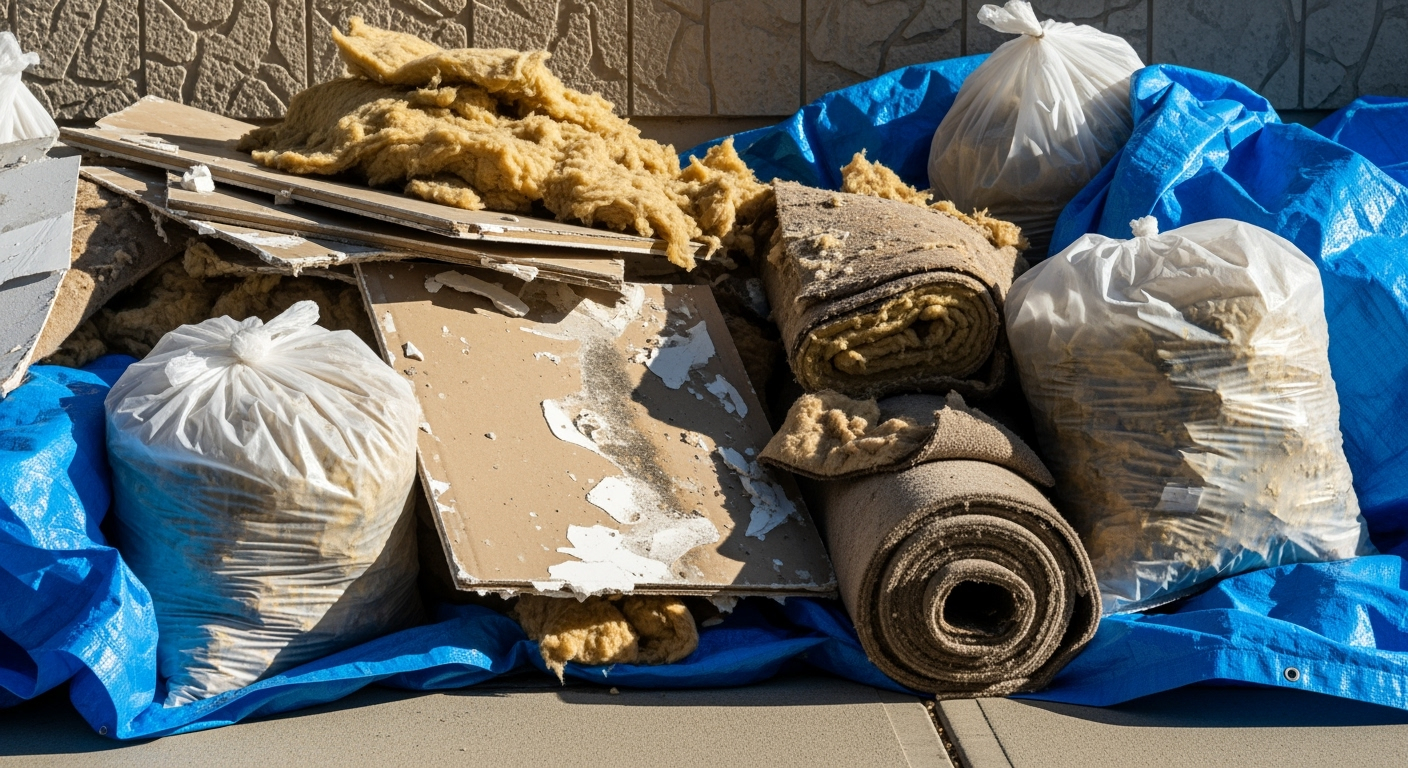
Insurance and Documentation
Proper documentation and insurance navigation significantly impact restoration outcomes and claim settlements.
Proper documentation is crucial for ensuring a successful water damage restoration claim—service teams help with this process.
Initial Documentation
Begin documenting immediately upon discovering water damage. Photograph and video all affected areas from multiple angles before any cleanup. Include close-ups of damaged items and wide shots showing extent. Document water sources if identifiable and any visible contamination—this helps repair teams assess the situation.
Create written inventories listing damaged items with descriptions, age, and approximate values. Save receipts for emergency expenses including temporary lodging, emergency supplies, and initial mitigation efforts. These expenses often qualify for reimbursement under additional living expense coverage—your restoration team can help organize documentation.
Working with Adjusters
Insurance adjusters assess damage determining claim values. Provide complete access to affected areas and share all documentation collected. Expert restoration companies assist by providing detailed estimates using industry-standard pricing software adjusters recognize—they help expedite the claims process.
Understand your policy coverage including deductibles, coverage limits, and exclusions. Most policies cover sudden and accidental water damage but exclude gradual leaks and flood damage from storms. Storm damage requires separate flood insurance through the National Flood Insurance Program—call your agent for clarification.
Claim Maximization Strategies
Maintain detailed restoration logs documenting daily progress, equipment placement, and moisture readings. Request copies of all technician reports and testing results. These documents support your claim if questions arise about restoration thoroughness or necessity—remediation teams help provide comprehensive documentation.
Consider hiring a public adjuster for large or complex claims. These experts represent your interests, often improving settlements significantly after their fees. They prove particularly valuable when insurers dispute coverage or undervalue damages from storm events common to coastal New Jersey—they help maximize your recovery.
Prevention and Maintenance
Preventing water damage costs far less than restoration. Regular maintenance and monitoring reduce incident risk by 70%—service teams can help identify vulnerabilities.
Plumbing System Maintenance
Inspect visible pipes annually for corrosion, loose connections, or wear signs. Replace supply lines regularly before failure—rubber hoses deteriorate causing many appliance-related floods requiring emergency repair service. Install water leak detectors near water heaters, washing machines, and under sinks for early warning—call for help selecting appropriate devices, especially in older Burlington County homes.
Maintain proper water pressure preventing pipe stress. Excessive pressure causes premature failures and connection leaks. Install pressure reducing valves if municipal pressure exceeds safe ranges—expert plumbers help prevent water damage, particularly important in high-pressure areas like parts of Delaware County.
Roof and Exterior Maintenance
Inspect roofing annually identifying damaged shingles, flashing deterioration, or gutter problems before storm season. Clean gutters twice yearly ensuring proper drainage away from foundations, particularly important in tree-lined neighborhoods throughout the Main Line. Extend downspouts well away from foundation walls preventing water infiltration—repair teams often trace damage to poor drainage.
Grade landscaping directing water away from structures with proper slope for the first several feet. Install French drains or swales managing surface water during heavy rains and storms common to the Northeast corridor. Seal foundation cracks preventing groundwater intrusion during wet seasons—remediation service prevents major issues in Pennsylvania’s clay soil regions.
Appliance Care
Replace washing machine hoses with steel-braided versions resisting bursting. Inspect dishwasher door seals and supply connections for leaks. Flush water heaters annually removing sediment that causes tank corrosion and failure—regular service helps prevent emergency repair calls.
Install drain pans under water heaters and washing machines containing minor leaks. Connect pans to drainage systems or water alarms alerting to problems before major damage occurs—these simple steps help avoid costly remediation.
Common Mistakes to Avoid
Understanding common mistakes helps property owners avoid worsening damage during water emergencies.
Being aware of common mistakes can facilitate a smoother water damage restoration process and help minimize repair costs.
Delayed Response
Waiting to see if things dry naturally ranks as the most costly mistake. Every hour increases damage exponentially—what starts as simple extraction becomes major restoration within days. Insurance companies may deny claims if delays appear negligent—call for service immediately.
Inadequate Drying
Using fans without dehumidification spreads moisture throughout structures causing widespread damage. Box fans lack power for effective drying while potentially spreading contaminants. Without moisture meters, hidden water remains causing mold growth weeks later—expert teams help ensure complete drying.
Ignoring Hidden Water
Water migrates through unexpected paths affecting areas appearing dry. Wall cavities, under cabinets, and subfloors harbor moisture invisible from surface inspection. Only expert moisture detection identifies all affected areas requiring treatment—service teams help locate hidden damage.
DIY Category 2/3 Water Cleanup
Attempting cleanup of contaminated water without proper protection risks serious illness. Gray and black water require expert protocols, protective equipment, and specialized disposal procedures. Health risks far exceed any savings from DIY attempts—call remediation teams for help with contaminated water.
⚠️ Important: Never use bleach as primary treatment for water damage or mold. Bleach doesn’t penetrate porous materials where problems originate and creates harmful chlorine gas when mixed with other chemicals—expert service teams use appropriate antimicrobials.
When to Call Experts
Certain situations always require expert intervention for safe, complete restoration.
Call service teams immediately for:
– Water affecting more than 25 square feet
– Category 2 or 3 water from any source
– Water contacting electrical systems
– Ceiling damage indicating overhead water
– Water present over 24 hours
– Sewage backups or toilet overflows with waste
– Storm flooding or groundwater intrusion
Expert assessment proves valuable even for seemingly minor incidents. Hidden damage often exceeds visible problems—what appears manageable might require extensive restoration once fully evaluated. Regional restoration experts understand local building methods and common problem areas—they help ensure complete repair.
Calling service teams promptly can help mitigate further damage during the water damage remediation process.
Investment Considerations
Understanding restoration economics helps property owners make informed decisions balancing costs with outcomes.
Restoration vs Replacement Economics
Expert restoration typically preserves most affected materials compared to complete replacement. Restoration maintains original character in historic properties while avoiding disposal costs and environmental impact. However, severely damaged materials or those affected by Category 3 water often require replacement for health safety—remediation teams help determine the best approach for properties throughout the I-95 corridor.
Time Value Considerations
Expert restoration returns properties to use much faster than traditional reconstruction. For businesses, reduced downtime preserves revenue and customer relationships. Homeowners avoid extended displacement and temporary housing expenses—service teams help minimize disruption, particularly important for families in school districts like Lower Merion or Princeton.
Long-term Property Value
Proper restoration maintains property values by preventing hidden damage becoming future problems. Properties with documented expert restoration sell faster than those with DIY repairs raising buyer concerns. Complete remediation prevents mold issues that significantly impact property values and salability—call for help protecting your investment.
Investing in water damage restoration service is essential for the long-term value of your property.
Insurance Premium Impact
Multiple water damage claims can increase insurance premiums significantly or trigger policy cancellation. Expert restoration reducing claim frequency protects insurability. Documented prevention measures may qualify for premium discounts with some insurers—repair teams help document improvements, particularly valuable for properties in flood-prone areas near the Delaware River.
Frequently Asked Questions
How quickly should water damage be addressed to prevent mold growth?
Water damage requires immediate attention within 24-48 hours to prevent mold growth. Mold spores activate in moist conditions and begin colonizing surfaces rapidly. Restoration service teams can mobilize within 1-2 hours, implementing antimicrobial treatments and proper drying protocols that prevent mold development while addressing the water damage comprehensively—call for help immediately.
Can I handle water damage restoration myself or do I need expert help?
While minor Category 1 water affecting less than 25 square feet might seem manageable, expert restoration service provides critical advantages. Remediation teams use industrial equipment, moisture detection technology, and proper drying protocols that prevent hidden damage and mold growth. DIY attempts often miss moisture in wall cavities or subfloors, leading to expensive repair problems later—call experts for assessment.
What are the signs that water damage has occurred behind walls?
Hidden water damage manifests through paint bubbling or peeling, musty odors, warped baseboards, stained drywall, or increased humidity levels. You might notice walls feeling damp or cool to touch. Expert moisture detection using thermal imaging and moisture meters can identify hidden water damage before visible signs appear, preventing extensive structural damage—service teams help locate hidden problems.
How often should I inspect my property for potential water damage risks?
Conduct visual inspections monthly for obvious issues like leaks or moisture. Schedule expert inspections annually for plumbing, roof, and HVAC systems. Check appliance hoses every 6 months and replace them every 5 years. After severe storm events, immediately inspect vulnerable areas like basements, attics, and around windows for water intrusion—call for help if you find issues.
Will my insurance cover all types of water damage?
Standard homeowners insurance typically covers sudden and accidental water damage like burst pipes or appliance failures. However, gradual damage from slow leaks, lack of maintenance, or flood water from storms requires separate coverage. Storm damage specifically needs flood insurance through the National Flood Insurance Program. Review your policy carefully and document all damage thoroughly for claims—restoration teams help with documentation.
What’s the typical timeline for complete water damage restoration?
Restoration timelines vary based on damage class and extent. Class 1 damage typically takes 2-3 days, while Class 4 specialty drying situations may require 7-14 days or more. The complete process including extraction, drying, cleaning, and reconstruction generally ranges from 1-3 weeks for residential properties, depending on damage severity and material types affected—service teams provide accurate timelines after assessment.

